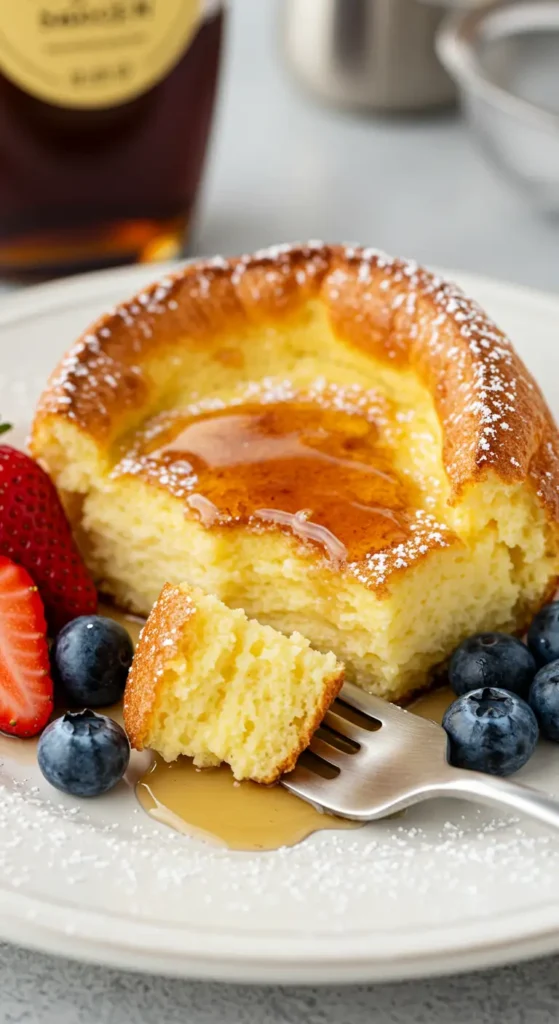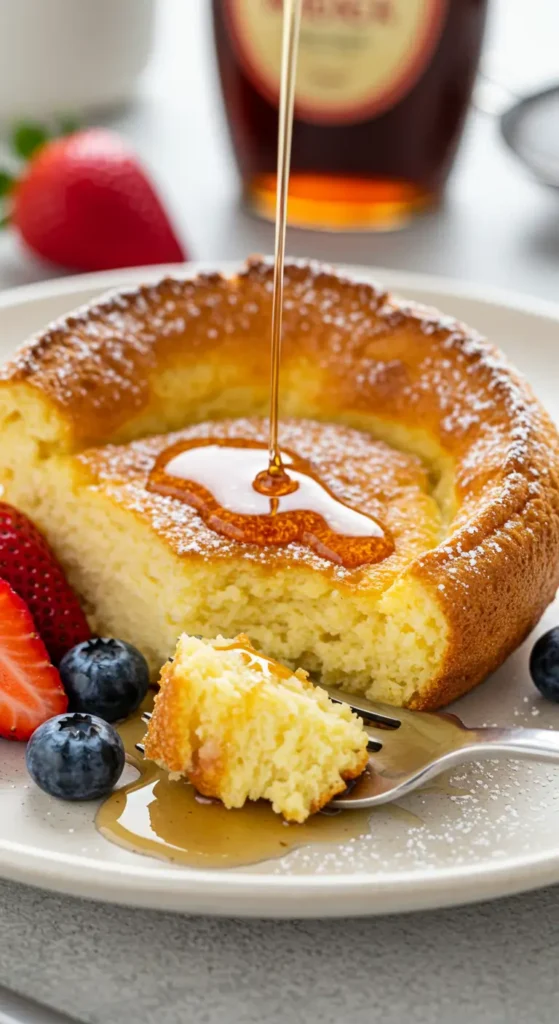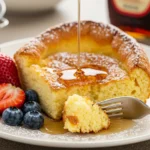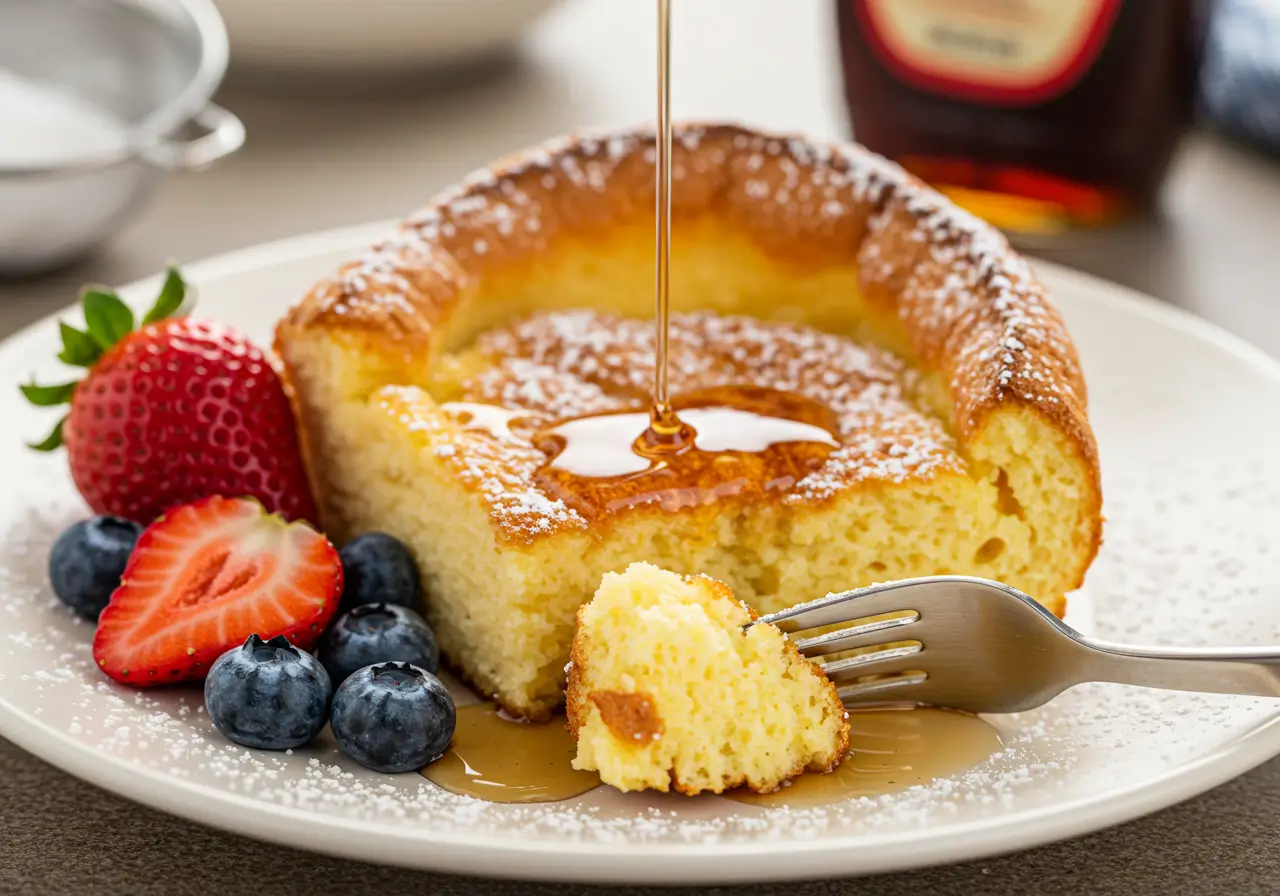Baked German Pancakes
Table of Contents
Looking for a breakfast dish that’s equal parts easy and wow-worthy? You’ve found it. This article dives deep into the world of the beloved Baked German Pancake — a golden, puffy marvel also known as a Dutch Baby or German Puff Pancake. We’ll walk you through everything: from ingredients and tools to foolproof baking steps, fun variations, and mouthwatering toppings.
You’ll also get tips on storing leftovers, frequently asked questions from real home cooks, and even a quick history lesson behind this fluffy favorite. Whether you’re a pancake newbie or a seasoned brunch pro, this guide has all the sizzling details to get you cooking with confidence.
Ingredients and Tools You’ll Need

Essential Ingredients for Baked German Pancakes
One of the beauties of a Baked German Pancake is how few ingredients it requires. Yet, every one plays a key role in its puffed-up success. Here’s what you’ll need:
- 6 large eggs
- 1 cup milk (whole milk works best for richness)
- 1 cup all-purpose flour
- 1 tsp vanilla extract
- A dash of salt
- 4 tablespoons butter (unsalted)
You probably have most of these on hand already — which makes this dish a go-to for quick breakfasts or spontaneous weekend brunches. It’s budget-friendly, fuss-free, and crowd-pleasing.
If you’re aiming for a fluffier pancake, use room-temperature eggs and milk. Also, don’t skip the butter — it helps the pancake puff and gives those crisp, golden edges that make a Baked German Pancake so irresistible.
Recommended Kitchen Tools
You don’t need fancy gadgets here. In fact, the magic lies in the simplicity:
- A 9×13-inch glass or ceramic baking dish, or a well-seasoned cast-iron skillet
- Blender or mixing bowl with a whisk
- Oven mitts (that pan gets hot!)
- Spatula or serving knife
- Measuring cups and spoons
Using a hot pan is key. So, preheat it in the oven with butter before pouring in the batter. This step helps create that dramatic rise when it bakes — a signature of any great Baked German Pancake.
How to Make the Perfect Baked German Pancake

Step-by-Step Baking Instructions
Making a Baked German Pancake couldn’t be easier. Just follow these steps, and you’ll have a golden, puffy breakfast ready in no time:
- Preheat your oven to 425°F (220°C).
- Place 4 tablespoons of butter into your 9×13-inch pan and put it in the oven while it heats.
- Meanwhile, blend the eggs, milk, flour, salt, and vanilla until smooth. You can use a blender or whisk by hand.
- Once the butter has melted and the pan is sizzling hot, remove it carefully from the oven.
- Pour the batter straight into the hot, buttery pan.
- Bake for 20–22 minutes until the pancake is puffed and golden brown.
- Remove from the oven. Expect it to deflate slightly — that’s normal!
Serve it warm with toppings like fresh berries, powdered sugar, or syrup.
Tips for Getting the Pancake to Puff Up Perfectly
Ah yes — the puff. That dramatic rise is the hallmark of a great Baked German Pancake. Here’s how to nail it every time:
- Always use a preheated pan — this gives the batter a head start to rise.
- Room-temperature eggs and milk mix more evenly, leading to better texture.
- Don’t overmix! Blend just until smooth. Overmixing can flatten your pancake.
- Keep the oven door closed during baking — opening it too soon can make the pancake collapse.
Common Mistakes to Avoid When Baking
Even though this recipe is beginner-friendly, a few hiccups can happen. To avoid a pancake flop:
- Don’t melt the butter in the microwave. The oven-heated pan is key.
- Avoid using cold ingredients straight from the fridge.
- Don’t swap in low-fat milk or margarine — these reduce flavor and puff.
- Resist the urge to peek! That quick drop in oven temperature can deflate your masterpiece.
With these tips in your back pocket, your Baked German Pancake will come out picture-perfect every single time.
Flavor Variations and Creative Add-ins
Sweet and Savory Flavor Twists
While a classic Baked German Pancake is a crowd-pleaser on its own, switching up the flavors can turn this staple into something entirely new. Feeling sweet? Sprinkle cinnamon and nutmeg into the batter, or swirl in a bit of apple butter before baking. You could even toss in sliced bananas or blueberries for a fruity kick.
Prefer something savory? Try adding shredded cheese, herbs, or even sautéed onions and mushrooms. It’s a brilliant way to transform a basic puff pancake into a savory brunch centerpiece. The possibilities? Pretty much endless.
These flavor upgrades aren’t just delicious — they also help you tailor the dish to fit the season, the crowd, or simply what you have on hand.
Adding Fruit, Spices, or Cheese
Want to take your Baked German Pancake to the next level? Try these simple add-ins before baking:
- Sliced apples tossed in cinnamon sugar
- Fresh berries with a drizzle of honey
- Lemon zest and poppy seeds
- Crumbled feta and sun-dried tomatoes
- Shredded cheddar and chives
Just remember: avoid overloading the batter. Too much moisture or weight can prevent your pancake from puffing properly. Add-ins should enhance — not sink — your masterpiece.
For more delicious breakfast ideas with a twist, you might enjoy this delightful French Toast Muffin Recipe on Smaczne Gotowanie.
Toppings and Serving Ideas
Best Toppings for Baked German Pancakes
When that Baked German Pancake comes out of the oven all golden and puffed, the fun really begins — it’s topping time! Powdered sugar is a classic. Just dust it on top, and you’re golden. But don’t stop there.
Here are a few tasty combos to try:
- Fresh strawberries and whipped cream
- Sliced bananas with a drizzle of chocolate syrup
- Greek yogurt and a spoonful of granola
- Maple syrup with crispy nuts
- Apple compote with cinnamon
The pancake’s eggy, airy texture pairs beautifully with both tangy and sweet toppings. So feel free to get creative based on what’s in your kitchen.
How to Turn It into a Show-Stopping Brunch Dish
Hosting brunch? Want to impress? This is where the Baked German Pancake really shines. Bake it in a cast-iron skillet and serve it hot at the table — straight from the oven. That rustic look combined with its puffed edges is pure wow factor.
Set up a DIY topping bar with bowls of berries, syrups, spreads, and nuts. It turns a simple breakfast into an interactive, joy-filled brunch that guests will remember.
You could also cut the pancake into squares and layer them parfait-style in jars with yogurt, fruit, and honey for a chic twist. However you serve it, this dish delivers both flavor and flair.
Storing and Reheating Tips
How to Store Leftovers
Let’s say you have leftovers (though that’s rare with a Baked German Pancake!). Don’t toss them — they reheat surprisingly well. First, let the pancake cool completely. Then, wrap it tightly in plastic wrap or transfer it to an airtight container. Pop it in the fridge, and it’ll stay fresh for up to 3–4 days.
If you’re planning ahead, this pancake also freezes like a champ. Slice it into portions, wrap each piece in foil or parchment, and store in a freezer-safe bag. When stored right, it can last up to two months.
Best Ways to Reheat Without Losing Texture
Now, about reheating — because no one wants a soggy pancake.
The oven is your best bet. Simply place your leftover Baked German Pancake on a baking sheet and warm it at 350°F for about 8–10 minutes. This helps keep the edges crisp and the inside fluffy. You can also use a toaster oven or reheat slices in a skillet over low heat.
Microwaving works in a pinch, but be warned: it tends to soften the texture. If you go this route, use 50% power and cover it with a damp paper towel to prevent drying out.
Baked German Pancake vs. Traditional Pancakes
Texture, Ingredients, and Preparation Differences
So, what sets a Baked German Pancake apart from your everyday stack of flapjacks? For starters, the texture. While regular pancakes are fluffy and bready, baked German ones are airy, custardy, and puffed with golden edges. Think popover meets crepe — but in a single pan.
The ingredient list is simple in both, but here’s the kicker: Baked German Pancakes skip the leavening agents like baking powder or soda. Instead, the puffiness comes from steam created during high-heat baking. That’s why preheating the pan is so important.
Also, with no flipping or standing over the stove, it’s a hands-off, oven-to-table kind of dish. Perfect for feeding a group with less effort and way more flair.
Which One Is Healthier?
It depends on your toppings and preferences. A Baked German Pancake typically uses less oil and has fewer added sugars — especially if you top it with fruit instead of syrup. Since it’s baked, there’s no need to slather on butter for frying either.
Want to go healthier? Use whole wheat flour, almond milk, or even add flaxseeds for a fiber boost. That way, you get the charm of a baked puff pancake with a little extra nutrition on the side.
Print
Baked German Pancakes
- Total Time: PT30M
- Yield: Serves 4
- Diet: Vegetarian
Description
This baked German pancake, also known as a Dutch baby, is a golden, puffed breakfast favorite with crispy edges and a custardy center. Made with just a few pantry staples, it’s perfect for an easy yet impressive brunch. Serve it straight from the oven with powdered sugar, fresh berries, or maple syrup for a comforting, home-style dish.
Ingredients
- 6 large eggs
- 1 cup whole milk (room temperature)
- 1 cup all-purpose flour
- 1 tsp vanilla extract
- 1/4 tsp salt
- 4 tbsp unsalted butter
- Powdered sugar, for dusting (optional)
- Fresh berries or syrup, for topping (optional)
Instructions
- Preheat the oven to 425°F (220°C).
- Place the butter in a 10- or 12-inch cast-iron skillet and set the skillet in the oven while it preheats.
- In a blender or mixing bowl, combine eggs, milk, flour, salt, and vanilla. Blend or whisk until smooth.
- Carefully remove the hot skillet from the oven and swirl the melted butter to coat the pan evenly.
- Quickly pour the batter into the skillet and return it to the oven.
- Bake for 20–22 minutes until the pancake is puffed and golden brown around the edges.
- Remove from the oven and let the pancake deflate slightly. Dust with powdered sugar and add toppings as desired. Serve immediately.
Notes
- For extra puff, make sure the eggs and milk are at room temperature.
- Use a hot skillet to achieve crispy, golden edges.
- You can substitute almond milk and vegan butter for a dairy-free version, though the rise may vary.
- Do not open the oven door during baking or the pancake may collapse.
- Prep Time: PT10M
- Cook Time: PT20M
- Category: Breakfast
- Method: Baking
- Cuisine: American
Nutrition
- Serving Size: 1 slice
- Calories: 260
- Sugar: 3g
- Sodium: 180mg
- Fat: 16g
- Saturated Fat: 8g
- Unsaturated Fat: 7g
- Trans Fat: 0.2g
- Carbohydrates: 20g
- Fiber: 1g
- Protein: 9g
- Cholesterol: 210mg
Keywords: baked German pancake, Dutch baby, puff pancake, German breakfast, oven pancake, easy brunch recipe, skillet pancake
Frequently Asked Questions
Can I Make Baked German Pancake Ahead of Time?
Absolutely! While Baked German Pancake is best served fresh from the oven (that puff is part of the fun!), you can prep it in advance. Simply blend the batter and refrigerate it in a covered container overnight. When you’re ready to bake, give it a quick stir, pour it into a preheated pan, and bake as usual.
You can also fully bake it the night before, store it in the fridge, and reheat it in the oven the next morning. Just note that it won’t puff up again, but the taste and texture will still be on point.
Why Didn’t My Pancake Puff Up?
There’s nothing more frustrating than a flat Baked German Pancake—but don’t worry, it happens. The main culprits are usually:
• The pan wasn’t hot enough
• The oven temperature was too low
• Cold ingredients were used
• The oven door was opened mid-bake
Stick to the tips in Part 3, and your pancake will rise like a champ.
Can I Make It Without Eggs or Dairy?
It’s tricky, but not impossible. Eggs are what give Baked German Pancakes their signature rise. However, some folks have had success using egg substitutes like aquafaba or flax eggs. For a dairy-free version, swap in almond milk and plant-based butter. Just know that the puff and flavor may differ slightly.
Are Baked German Pancakes Good for Meal Prep?
You bet! Once baked and cooled, they can be sliced and stored in the fridge or freezer. Wrap individual portions for quick breakfasts all week long. Reheat as needed, and enjoy a warm, tasty pancake anytime.

